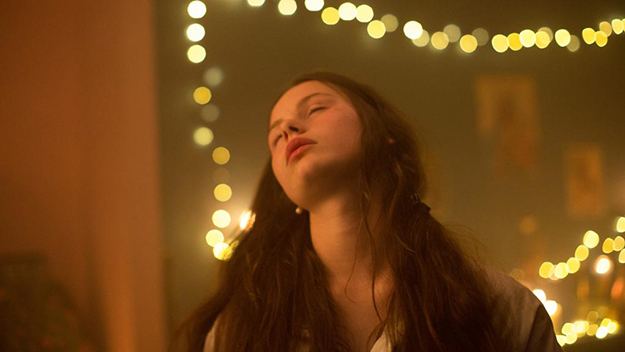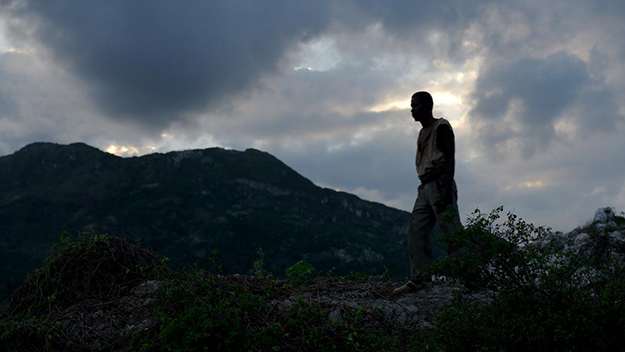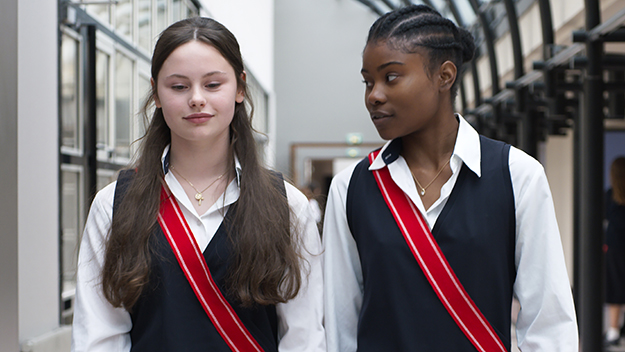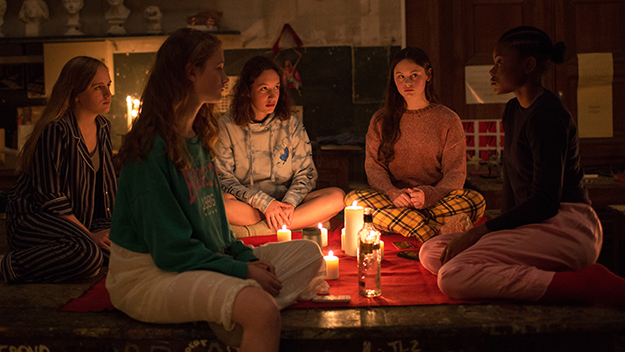Interview: Bertrand Bonello

Images from Zombi Child (Bertrand Bonello, 2019)
Of all the cinematic sub-genres to be reanimated and recontextualized for modern audiences in recent years, the zombie film has arguably grown the most predictable, and the most tired. For his own stab at the subject, Bertrand Bonello has done something straightforward but stimulating: the French director’s eighth feature, Zombi Child, traces the history of zombie lore from its roots in voodoo to a fictionalized present day in which its lingering influence continues to manifest in unexpected ways. The film tells two parallel stories: the first, set in 1962 and based on the story of Clairvius Narcisse (a Haitian man who was reportedly drugged, buried alive, and resuscitated in order to work on a plantation), situates the very idea of zombies in a historical continuum. The second, set in contemporary Paris, follows a group of female students at the Légion d’honneur boarding school who learn that their new classmate, a Haitian girl named Melissa (Wislanda Louimat), is Clairvius’s granddaughter and that her aunt (Katiana Milfort) is a practicing voodoo sorceress. Intrigued, Fanny (Louise Labeque), the ringleader of a secret school sorority, tries to use Melissa’s aunt’s powers to resolve her romantic entanglements, but this cross-pollination of interests soon leads to a violent collision of past and present transgressions. In juxtaposing these stories, Bonello (who also wrote the screenplay and composed the moody, evocative score) constructs a provocative dialectic based around notions of history, colonialism, slavery, and exploitation. Furthering his recent interest in youth culture and the ramifications of France’s political legacy, the film brings a genre known largely for easy scares and satire into a realm of grave and unsettling consequence.
Following Zombi Child’s premiere in the Directors’ Fortnight program at the 2019 Cannes Film Festival, Bonello met up at his hotel to discuss the film’s swift production, the political and logistical hurdles to shooting in Haiti, the romanticism of youth, and the utility of genre cinema for conveying political content.
From what I understand, Zombi Child came together rather quickly, with production starting just over a year ago. How long prior to that had you considered making a zombie film?
I first had the idea about 15 years ago. At that time, for some personal reasons, I was very interested in Haiti and I was reading many books about Haitian history: journalism books, ethnological books, etc. When you read about Haiti you very quickly arrive at voodoo, and then, quite quickly, arrive at zombies. Prior to this I didn’t know the origin of zombies. I was very surprised, very fascinated and moved, and I just put that idea in the back of my head. And about a year ago, I was trying to do a big feature, which was not easy to finance. So I said to myself, “I want to make a small film instead, very quickly. I’ll start writing now, I’ll shoot in four months, and have the film finished for Cannes so it can be released in France in June.”
It was then that I began thinking back to this zombie stuff, and I thought that this story of Clairvius, a man who walks the lands of Haiti, would be quite simple to shoot. Plus there is a strong idea behind the story, which is slavery and questions about slavery. So that’s why I came to the project. But after that I had to find the right point of view for the story, because, of course, I’m not black—I’m French. So the film could not be set only in Haiti. You can’t come in and say, “Okay, I’m going to make a film about voodoo and zombies.” So I had to find a French point of view for the film.
So while it is a true story, I also invented some stuff. For example: the fact that Clairvius has a granddaughter, with parents who died in the 2010 earthquake. For me this character and his granddaughter, now living in France, would be the perfect point of view. That’s the link. And I knew I didn’t want to have adults, so I found this boarding school and we went from there. But it is true that the first thing I wrote was the shooting schedule because I knew if I wanted to shoot in four or five months that the budget would have to be like 1.5 million and we’d have to shoot over just three or four weeks, not more. So I wrote with all that in mind.
Did you learn about Clairvius in your initial research, or did you come to his story once the project took off?
No, I learned of him 15 years ago too. It is quite famous. It’s one of first recorded stories of zombies coming back. When this story first started to travel, around 1980, North Americans were very fascinated, because they wanted to know the secret of the [tetrodotoxin and datura] powder that allowed Clairvius to remain alive after being buried. It’s a very powerful image. Doctors and anthropologists were sent to Haiti to investigate. The Canadian scientist and author Wade Davis wrote a book about this called the The Serpent and the Rainbow, and then Wes Craven made a film based on the book, which is very much about the powder.
Was one of the things that interested you about this story the fact that you would be able trace zombie mythology back to its roots, and portray this history in a more realistic register than we normally see in zombie films?
Yeah, I liked the idea of taking on a very famous figure—“the zombie,” we all know, is almost a pop figure. So to start from there and go back to the origin interested me. And with this movement between periods, to talk about slavery, and the relationship between France and Haiti, which has a very tough, complicated history with regards to slavery. I wanted to trace all this to its origins, to something much more real and human, because these people, they’re not dead—theoretically they’re people that don’t find a place in hell, so they come back to earth. They’re alive, they’re between life and death, between night and day.

It’s interesting in that sense that you chose to shoot so many sequences day for night.
Yes! Quite a lot, in fact. We were trying to find a kind of texture. I did day for night, but not to pretend it’s night, but to find something more oneiric, a feeling between life and death.
You mentioned the Wes Craven film, but it’s hard not to think Jacques Tourneur’s I Walked with a Zombie when watching this movie. Did you look back at the Tourneur film for inspiration?
Yeah, that was the only one.
It’s one of the only other fictional movies I can think of that looks to the roots of zombie lore.
Right. And there’s the film by Jean Rouch, The Mad Masters. But all the other influences were in literature and books. But in terms of films, Jean Rouch and Jacques Tourneur.
What was it like shooting in Haiti?
Everyone told me, “Don’t go there, it’s impossible! It’s the most difficult country to shoot in.” But I really wanted to go there, because production-wise what I had to do was not so much, and if I didn’t do it in Haiti, for me, it would lose its essence. It’s kind of ethical, political. But yes, it was very difficult, for many reasons. First of all, for cultural reasons: if you arrive as a white person and say, “I’m going to make a movie about voodoo,” they’re really scared. So it takes a lot of time to be accepted, to explain the project, to explain the point of view, to let them know that you’ve read and researched a lot. You have to listen and be patient—it takes time but we met some amazing people.
And it’s also difficult because nothing works! The country’s a disaster. You’re happy if you can simply drive a car. Last year there were riots, political riots all over the place. The country was really stuck. But we managed to make it. If there is something I’m really proud of it’s that we could make the film in Haiti.
Are the people we see in the Haiti scenes actors, or are these locals that you cast?
Mainly actors. The producer in Haiti said, “We’d like for you to meet these people and give them work,” if possible. As an actor in Haiti you can’t make a living. Most of them do TV, theater, dance, and even sing, you know.
As far as the contemporary scenes, what made you think to contrast this 1960s period with the story of a young French girl and her romantic relationship?
Well, I wanted to have two simple stories: one about a man that is put in a grave and comes back as a slave, and then another about the sorrow of a young teenager. I felt that when you put them together, it could open many doors, and add many levels. The film gets more complex as it goes. Of course as a filmmaker I like these contrasts: between present day and 1962, between France and Haiti, between something dark and something light, but also between the girls, who talk a lot, and the men in the Haiti story who don’t speak at all. More and more in my films I like the idea of contrasts.
In this film, it’s interesting because for most of the story you crosscut between the two periods, as opposed to some of your recent work in which historical flourishes come from within certain contained time periods, rupturing these more contemporary stories.
Right. But then you can also think of all the Haiti scenes in this film as coming from the head of the young girl. There’s this oral tradition in which we tell stories. Maybe she heard the story from her mother or grandmother, and this is how she thinks it was.

A lot of your recent films have dealt with young people. While I was watching this movie I thought of a quote by Jim Jarmusch who, regarding his very different zombie film The Dead Don’t Die, said: “Through history, teenagers have created the hallmarks of literature, art, style, and music. My heart is always with the teenagers.” I’m curious how you think about youth culture and young people nowadays?
There is something very romantic in this age. For example, in Nocturama, the romanticism of the young people was very important for me, for the characters. Otherwise, if they were even, say, 26 years old, it gets cynical. I don’t like much cynicism in films. At the age of 20, when you say, “I want to blow everything up,” it’s still somehow romantic. And for the young girls in this film, it’s the same: it’s an age at which you are still a kid but you’re thinking as an adult. But despite these thoughts you still have a kind of innocence. This film has many components: it’s a teen movie, it’s a genre movie, it’s an ethnological film—there is a documentary aspect, a history lesson. It’s a hybrid.
Did you collaborate with the actresses at all on the dialogue or their characters?
Since I had to shoot very quickly there was no improvisation. We did some rehearsals on the weekends before, just to get them to know the dialogue and the tempo really well. But when you do this kind of film, it’s not directing actors. It’s taking a lot of time to choose the girls—the casting is very important. For the dialogue, I have a 15-year-old daughter, so she helped me with the language—to get the right music. I know you’re not French, but everybody’s told me that musically the language is perfect. My daughter was like, “Don’t use this word—that’s like, two years ago, come on now.” So for the girls it was very easy, because it’s their words, it’s their music.
Your last two films have both been genre films, but very political genre films. Do you find genre to be a useful tool to convey politics?
Yeah, I think so. When I was a teenager I watched a lot of genre movies, by George Romero, John Carpenter, David Cronenberg—people from that period, the end of ’70s to the beginning of the ’80s. And I enjoyed these films, but when I saw them again when I was older I realized that they were not only very good films but that they had strong political meaning. All of them. I think it’s the political dimension of these films that has been lost in genre movies in the years since. These movies were tyrannical, and these directors, they used cinema to tell of their fear of the world. That’s why today I think you see genre movies coming back. I think it’s a way for directors to speak about their fear of the world—by using the cinema of fear, in a way.
Was there also an interest on your part, following a number of historical films, to tell more contemporary stories?
Yes, I think after Saint Laurent I needed to move back to contemporary stories. I began shooting in digital for the first time, and I just felt I needed to come back to modern stuff. But now I’m thinking about a period film again.
Can you tell us a little about the score you wrote for this film, and how you go about composing your scores in general? Your original music has recently been spotlighted in the U.S. with a compilation of your scores, but I feel like your use of pop music often overshadows your own musical work.
I usually think about the music, my own music and the pop songs, during the script-writing process. If I write a scene, and I feel that the scene will need some music, I go to my studio and I start to search for sounds, for notes, and then I go back to writing. Sometimes I feel like the writing isn’t finished until I’ve found the sound or the song. So usually when the script is finished, all the music is finished as well. When I go into the editing room I have all the scenes and all the tracks. Because I want to use the music as something that says something. For me, it’s part of the dialogue.
Earlier this week you deejayed the John Carpenter awards ceremony for the Directors’ Fortnight tribute, right?
My god, it was worse than that! We played two of his songs before giving him the prize. We played “Halloween” and “Assault on Precinct 13.”
There’s a movie in Cannes’ main competition called Bacurau that uses a John Carpenter song and also references his name at one point.
Yeah, someone told me about that. It’s a strange year.

Can you talk a bit about the editing process, the decision to crosscut between time periods, and just generally about establishing the rhythm of the film?
Well, the finished film is exactly as written in the script. But when you’re trying to tell two different stories it’s always a risk, because it’s a little ethereal. You have to wait until after the first edit to see if it works. Of course, the risk is that some people will like one part more than another, so after, even if it’s very close to the script, there is a lot of work to maintain an equilibrium. For example, when it’s good cut from France to Haiti, or from Haiti to France—or whether this or that is a little long. I had many scenes that could be either one minute or, like, four minutes. I waited until the last day to really find the good length for the history lesson, for example, because I had around fifteen minutes of footage. When it’s a dialogue scene, editing is quite easy, because the length of the scene is the length of the scene. But when the script says something like “girl walking,” or “girl brushing her teeth,” finding this equilibrium is more difficult. It’s more like music. It’s a delicate balance.
What was it about this particular boarding school, and this kind of privileged generation of young people that interested you?
I was looking for a boarding school for young girls. I was thinking, “Does this kind of school still exist?” So I just did some research on the Internet, and I found this school I didn’t know about. This school was created by Napoleon, and for me, it was great, because the relationship between Napoleon, Haiti, and slavery is very important. So I felt that was a good sign, so I decided, this is where I’ll set the film. As French people have seen the film they’ve been very surprised by this school. They weren’t aware this kind of school still exists. But everything is true—everything you see is the way the school really is today, from the uniforms to the way the way the girls compose themselves. I didn’t invent anything.
Did you go to the school and observe the students beforehand?
Yes, I went there many times. They invited us in, and they were really nice. But it was very surprising, because it sort of feels like time stops, you know? The school is in a suburb that’s actually quite tough—the contrast is quite crazy.
You say you were looking for a boarding school for girls, but was that always the case, or was it originally just young people in general?
At first, young people in general. But when I found this place, it’s very particular, because it’s a big institution in France, and it has political meaning. It’s like the elite of France.
Where did you find Wislanda Louimat, the young Haitian girl?
In Paris! It was quite difficult, because we don’t have many Haitian people in France, or at least not as many as in New York or Montreal. I really wanted a girl who was born in Haiti and had left, someone who had this double cultural identity. And Wislanda, she’s exactly that character.
Did she have any knowledge of this story or the history that the film explores?
Yes, she knew all about that—zombies, spirits. Even if you don’t believe in voodoo, you know all that history. When we were casting the people in Haiti to play the zombies, I would say to them, “How do you think a zombie walks?” And they all do it the same way. Because since they were kids they’ve known this history: they know the way to hold their head. They know the voice. They all know.
That’s one of the things I liked about those scenes: I don’t know if it’s more realistic, but there’s a unique way the actors walk and carry themselves. It’s different from how you normally see zombies portrayed in American movies.
I almost didn’t direct the actors on those scenes. They knew better than me. It’s their culture.
You’re obviously juxtaposing many topics in the film, most related to France’s colonial past. How were you hoping to convey the politics in this film?
Well, I don’t want to give lessons or anything, because it’s not my place. But when I saw the film for the first time the meaning became much more clear. I don’t start a film with big ideas—I just think about details. The film is really about the transmission of freedom: how you can give this idea to the next generation, and what do you do with your history? In Haiti, of course, for this girl, she carries a huge history. How can she live with that? And, in France, as the history teacher says, “France is the revolution—it’s freedom.” But have we been always good with that? How can we tell this story? Can you tell it in a straight way? And for me, the political part of the film lies in those questions. It’s not, “France behaved badly.” That’s not my aim. I’m not here for that. The question is simple: What do you do with your own history?
Jordan Cronk is a critic and programmer based in Los Angeles. He runs Acropolis Cinema, a screening series for experimental and undistributed films, and is co-director of the Locarno in Los Angeles film festival.







